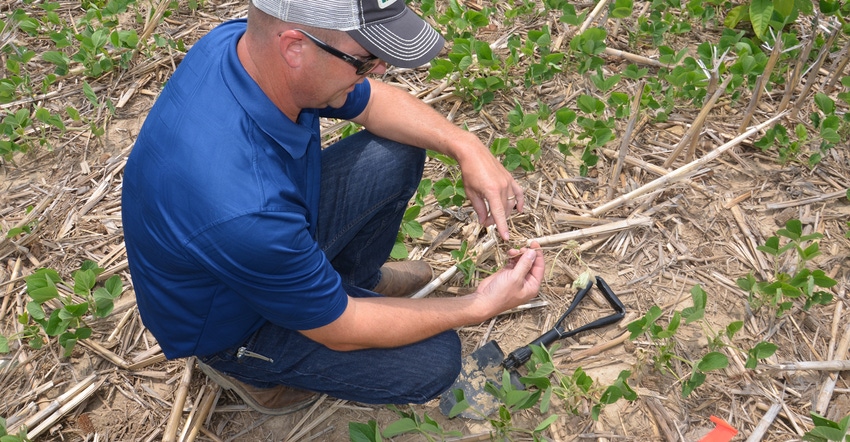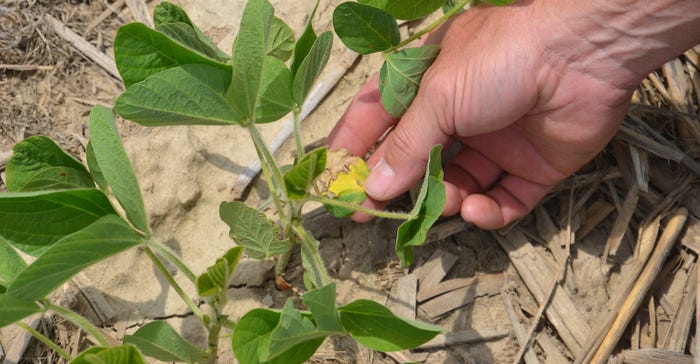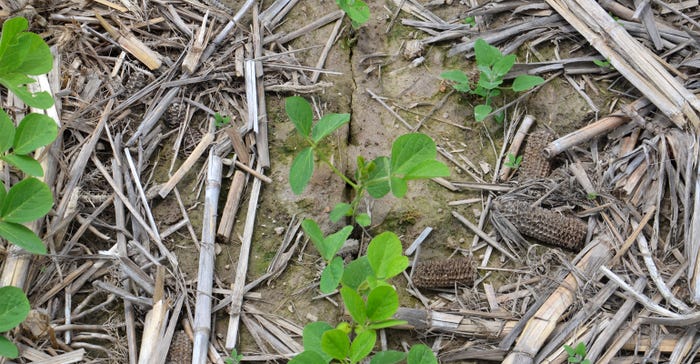
Whether or not it winds up making a difference to yield, if it happens in a soybean field, Steve Gauck likes to know about it. That’s why he scouts the Soybean Watch ’18 field as often as possible. Even if something shows up that doesn’t wind up impacting yield this year, it might have an effect in the future. More importantly, it might cause you to rethink your management plans to avoid a potential problem in the future.
Gauck, a Beck’s sales agronomist based in Greensburg, Ind., found such an issue while scouting the field in early June. The Soybean Watch ’18 project is sponsored by Beck’s.
“I found some plants with signs of metribuzin injury,” he says. “It was very minor here, and was more of something I just happened to pick up than a real problem. However, I got quite a few calls in early June from farmers who had bigger problems with metribuzin injury.
“Normally soybeans grow out of it. However, in extreme cases, it can be severe enough to cause significant damage.”
 DISCOLORED LEAVES: This discolored leaf is a sign of metribuzin injury. Overall, injury was minimal in the Soybean Watch ’18 field.
DISCOLORED LEAVES: This discolored leaf is a sign of metribuzin injury. Overall, injury was minimal in the Soybean Watch ’18 field.

The major symptom Gauck usually finds on relatively young plants is browning and discoloration on the edges of young leaves. This year when that appeared, soybeans were typically in the V2 to V4 or even V5 growth stage. Usually, if metribuzin injury appears on soybeans, it’s related to weather conditions at or after planting, he adds. This year, relatively dry weather for a period after planting seemed to allow injury to show up.
Other reasons
Gauck acknowledges that he saw more damage than he has seen in a while. However, weather likely isn’t the only reason for finding symptoms of metribuzin injury on young soybeans.
“Many people are using more metribuzin again than they did for several years when many people relied heavily on glyphosate,” he says. “The rise of resistant weeds and tall waterhemp has caused people to go back to using some other chemistries again. As that happens, we’re seeing some of the things we used to see again.”
In some no-till fields, for example, where soybeans were no-tilled into cornstalks, Gauck believes there may have been another situation adding to the frequency of metribuzin injury. Closing the planting slot with closing wheels is important for more reasons than just getting good seed-to-soil contact and promoting good, uniform emergence, he emphasizes. If the slot isn’t closed properly, it’s an open avenue for a compound like metribuzin to move into the slot and perhaps contact the soybean seedling when it might not otherwise have that kind of contact.
“Especially if the soil was on the tacky side and the slot wasn’t completely closed here and there, we tended to see a bit more of it,” he says. “Typically, I could find the browning on leaf edges on a few seedlings if the slot was left open in a spot or two.”
 OPEN SLOT: An open seed slot is an invitation for compounds like metribuzin to work down and make contact with seedlings.
OPEN SLOT: An open seed slot is an invitation for compounds like metribuzin to work down and make contact with seedlings.

While it’s not likely to cause issues for yield, Gauck says this early observation is a reminder to think through herbicide programs and options carefully when planning management of soybeans for next season. As you go back to herbicides that you haven’t used for a while, you need to make sure you are familiar with their characteristics,” he says.
The soil pH can also interact with a chemical like metribuzin. One small field where there was a serious problem with metribuzin injury this spring was likely related to it being used in combination with the existing soil pH, he concludes.
About the Author(s)
You May Also Like




